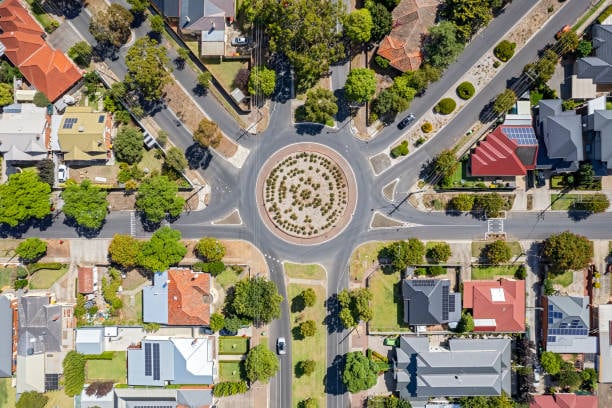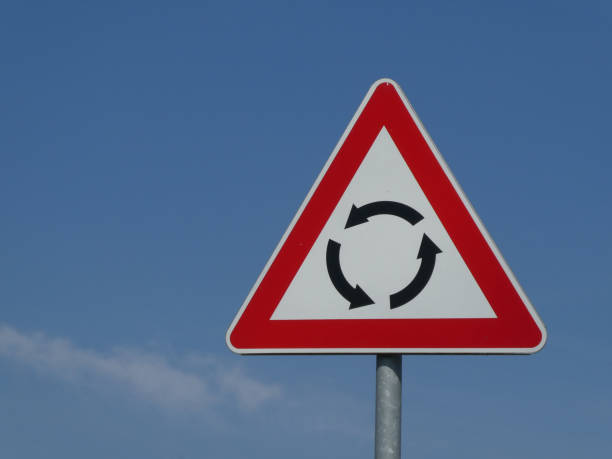What are roundabout rules NSW? Let’s first discuss the definition and application of roundabouts before reviewing those guidelines. When traffic is allowed to run in a single direction around a central island, it is called a roundabout. The circulating flow usually has priority at these types of circular intersections.
It’s important to slow down and give way when a roundabout sign appears in order to avoid any kind of car accident. Because the law requires low speeds for traffic entering roundabouts, its design aims to slow traffic entering the junction to improve safety so that the roads typically approach the junction radially.
Instead of using roundabouts, we can also call them rotaries, traffic circles, and circuses. They are present on roads of many countries worldwide and are becoming increasingly popular in Australia.
Benefits of Using Roundabouts in NSW
Roundabouts are becoming increasingly common in New South Wales (NSW), and for good reason. They offer several benefits over traditional intersections with traffic signals or stop signs.
Better Movement of Traffic
In addition to handling more traffic than conventional intersections, roundabouts help ease traffic congestion. This is so that traffic can flow constantly through roundabouts without forcing vehicles to stop and start their engines.
Decreased Injuries
Accidents can be decreased by roundabouts, particularly head-on and right-angle crashes. This is so that vehicles have more time to respond and prevent collisions since roundabouts require drivers to slow down and yield to traffic that has already entered the roundabout.
Increased Efficiency
Because roundabouts eliminate the need for cars to frequently stop and start their engines, they can lower pollutants and fuel consumption. This is particularly advantageous in places where there is a lot of traffic.
More Aesthetically Pleasing
Roundabouts can be more attractive than traditional intersections and provide a space for landscaping and other features. This can improve the overall look and feel of an area.
Increased Safety for Pedestrians and Cyclists
Roundabouts can be safer for pedestrians and cyclists than traditional intersections. This is because roundabouts force drivers to slow down and yield to pedestrians and cyclists, which gives them more time to cross the road safely.
What is the Black Spot Program in NSW?
In New South Wales, the government has been actively promoting roundabouts and continuously executing roundabout projects for 2022-2023.
For one, the Black Spot Program provides funding for safety improvements like traffic lights and roundabouts in areas where numerous fatal collisions are known to have happened or are likely to occur in the future.
These 93 Black Spot projects will build on prior investments made in the state and significantly reduce severe injuries and fatalities on New South Wales roads. This is good news for drivers, pedestrians, and cyclists in the state. Ultimately, roundabouts make our roads safer, more efficient, and more pleasant.

Roundabout Road Rules in NSW: General Rules
Roundabouts can be confusing for drivers who are not familiar with them. This is why there are roundabout rules NSW to guide all road users on how to use it.
General Rules
Generally, the rules for using roundabouts vary from country to country, but they typically include the following:
- Give way to traffic already in the roundabout. This is the most important rule to remember when using a roundabout. You must give way to all vehicles already in the roundabout, even if they turn in the opposite direction.
- Indicate your intention to turn. You must indicate your intention to turn before you enter the roundabout. If you are going straight ahead, you must indicate left as you approach the roundabout.
- Stay in your lane. If you are turning left, you must stay in the left lane. If turning right, you must stay in the right lane unless signs or markings indicate otherwise.
- Do not stop at the roundabout. If you need to stop, you must pull over to the side of the roundabout and wait for a safe gap in the traffic.
Roundabout Rules NSW
Service NSW establishes the following roundabout rules NSW:
1. Turning Left:
Turn left from the leftmost lane if there are no lane markings indicating otherwise.
Signal left before turning and yield to all traffic with the right-of-way.
Maintain your left turn signal until you’ve completed the turn.
2. Going Straight:
Proceed straight ahead in any lane unless lane markings restrict you to turning left or right.
You may optionally signal left before changing lanes to exit the intersection (advises following drivers).
3. Turning Right or U-Turn:
Turn right from the rightmost lane unless lane markings specify otherwise.
Signal right before turning and yield to all traffic with the right-of-way.
Maintain your right turn signal until you’ve completed the turn.
Other Roundabout Rules NSW
- Changing lanes. To avoid changing lanes inside a roundabout, make a plan as you approach one. You must signal and yield to any oncoming traffic whenever you need to switch lanes. Only areas with broken white lines allow lane changes. If the line is intact, changing lanes is not permitted. Never forget to look in your blind spot before changing lanes.
- Exiting. You must do so if it is possible to signal left when leaving a roundabout. As soon as you leave the roundabout, you must immediately stop signalling. It might not be practical to gesture left when exiting a small, single-lane roundabout while moving straight ahead.
- Pedestrian crossing. Unless there is a pedestrian crossing, you need not yield to pedestrians when making a left or right turn at a roundabout. However, you must always exercise caution to prevent hitting a pedestrian.
- Bicycles and roundabouts. On a roundabout, keep an eye out for bicyclists. They have the right to an entire lane. Moreover, bicycle riders are subject to the same regulations as other motorists. On a multi-lane roundabout or multi-lane roundabouts, they can turn right using the left lane. They must yield to vehicles exiting the roundabout when turning.
Roundabout Rules NSW: Traffic Signs
A: Road sign showing roundabout ahead; B: Road sign showing you must give way to vehicles on the roundabout
If you see these signs, slow down and prepare yourself to stop. Even if there are no other vehicles in the roundabout, you should slow down and be prepared to stop if someone enters the roundabout from your right.
You should also use your indicators early and often to help other drivers know what you plan to do. To understand more about roundabouts, here’s a video from Transport NSW:
Do You Need Help With Your Traffic Law Matter?
If you have been charged with a traffic offence involving a roundabout in New South Wales, consider hiring a lawyer. Traffic offence lawyers at JB Solicitors can help you understand the charges against you, explain your legal options, and represent you in court.
Choosing a lawyer who has experience in traffic law and has a good reputation is crucial. You should also ensure that the lawyer you choose is someone you feel comfortable with and can trust.
Contact us now if you need help with your traffic law matter.
